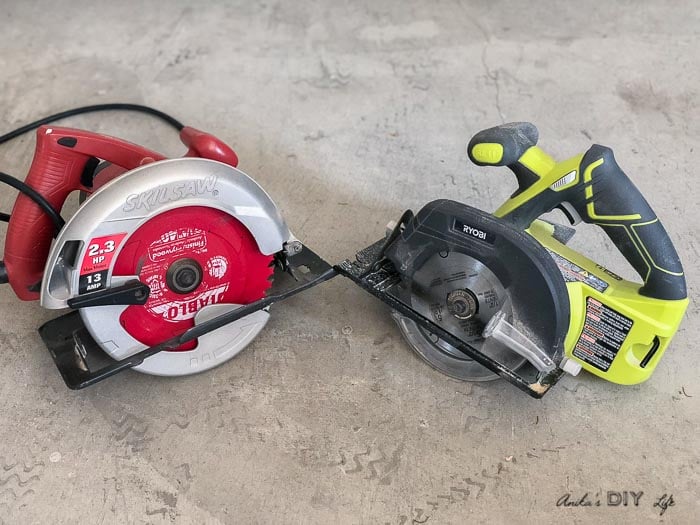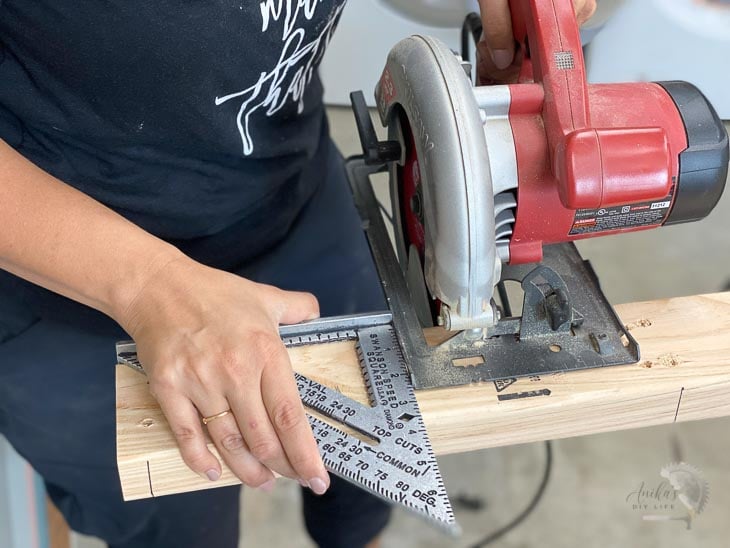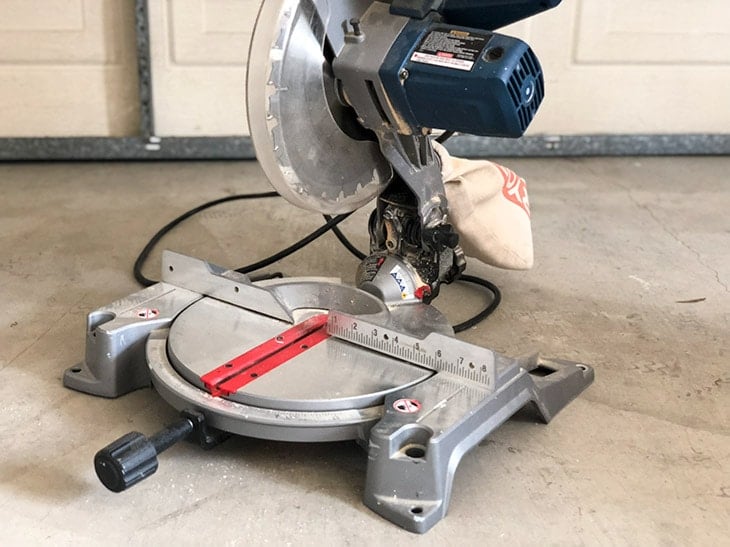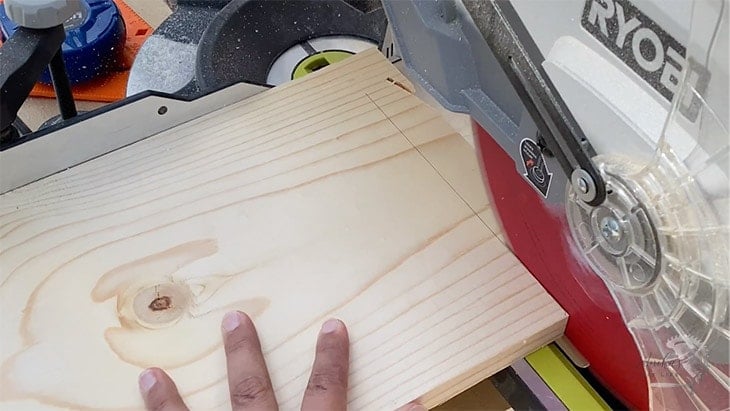Miter Saw vs Circular Saw – Differences and which one to choose
What are the differences between a miter saw vs. circular saw, and which one is right for you? If you are looking for a power saw to help make it easier to do woodworking projects, I have all the details you need to help you choose this article.

Many types of saws are available to woodworkers, but the miter saw and circular saw are the most popular first choices for beginners and are essential tools in the workshop.
Both miter saws and circular saws essentially have round blades that spin at high speed powered by an electric motor and cut through different materials like wood, PVC, and even soft metal like aluminum.
The size of the circular blade used in the saw helps determine the size of the saw, and in turn, that determines the thickness of the material it can cut.
However, there are some major differences in terms of where each can be used.
Let’s dive into it!
Differences between a circular saw and a miter saw
Although both saws can make cuts in various materials, there are a few key differences between the saws in their capabilities and other characteristics.
- A circular saw is a small and handheld while a miter saw is a large stationary saw that sits on a table.
- In a miter saw, the material is placed on the saw and the blade is pulled down to cut it whereas in a circular saw, the blade is pushed through the wood.
- The maximum width of material that can be cut by a miter saw depends on the size of the miter saw blade and sliding arms whereas, the circular saw can cut through any width of board.
- Circular saw is great for breaking down large sheets of plywood etc., whereas, a miter saw is used to cut down long boards.
- The miter saw is more precise than a circular saw. The handheld nature of a circular saw makes it more prone to user error and variation.
- Circular saw is less expensive than a miter saw
- Circular saw doesn’t need a lot of storage space and can be stored in a cabinet or large drawer whereas a miter saw will sit on a worktable.
- Miter saw is safer than a circular saw.
Here is a handy graphic summarizing the differences –

What is a Circular Saw
A circular saw has an encased circular blade and a wide metal base that sits on the material to be cut. Circular saws typically have blades that spin around an arbor axis perpendicular to the table surface, like with a table saw. Still, unlike table saws where you push the material through the blade, you push the blade through the material to make long cuts in circular saws.
See all about how to use a circular saw including a video tutorial here.

You can set the blade’s depth for the material you are cutting and guide the blade along the line that needs to be cut. Most circular saws allow you to change the base plate’s angle to make bevel cuts too.
A circular saw’s primary purpose is to make straight cuts in lumber – cross-cuts in boards and rip-cuts in plywood. It is especially a great tool to help cut down large sheets of plywood.

Circular sizes and blades
Circular saws come in different sizes, which are determined by the size of the circular saw blade, which determines the total thickness the saw can cut. The most common circular saw blade size is 7 1/4 inches, but you can also find smaller ones that are easier to handle. These blade sizes aren’t interchangeable, so you should always use the correct one for the saw you have.
Additionally, the tooth count determines the quality of the cut. The lower the count, the rougher the cut. I always recommend using a higher tooth count to avoid splinters in the goods.
Circular saws are available in cordless and corded versions, making this a portable and versatile tool.
Pros of a circular saw
- Small footprint – easy to store in a large drawer or closet if needed.
- Portable and lightweight – can be easily carried from one job site to another.
- Less expensive – budget-friendly options start at $40!
- It can be used for making continuous long continuous.
- It works best to cut straight lines but can be used to cut mitered and beveled cuts.
Cons of a circular saw
- To ensure a straight cut, you have to use an additional jig or guide – this is VERY important, or the blade can jam, leading to a lot of frustration. There are many options available for this in the market (listed below) or you can make a homemade jig too.
- More prone to causing injuries if you don’t follow proper safety guidelines.

Are circular saws dangerous?
Circular saws, like any other saw, come with their set of dangers when not used properly. The blade guard is an important part of the safety mechanism and should never be removed.
Another common reason for a circular saw blade getting stuck is not being pushed in a perfectly straight line. This can cause the blade to bend and pinch, causing the saw to get stuck. Additionally, if the board on both sides of the cut is not well supported, it can lead to the blade getting pinched, resulting in kickback or the blade getting stuck. The best way to avoid this is to use clamped straight edge as a guide.
What is a Miter Saw
Miter saws, also often called chop saws, are tabletop saws where the blade is mounted on a moving arm to make crosscuts at specific angles ranging from a 45-degree angle to a 90-degree angle. The arm can move up and down so to help make precise cuts.

Depending on the miter saw model, you can make accurate cross cuts, miter cuts, beveled cuts, or compound cuts. The miter and bevel angles can be set to precise different angles using the bevel and miter gauge. This is especially beneficial if cutting crown moldings.
Miter saws also come in different sizes, and the size of the blade and length of arm determines how wide a board can be cut on the saw. While you can also find a cordless model, these are usually corded.
The one thing a miter saw cannot do is rip cuts. It is just not safe!
Types of miter saw
A few different types of miter saws are available in the market based on the type of cut they can make.
BASIC MITER SAW
- The table rotates to make angle cuts also called miter cuts.
SINGLE BEVEL COMPOUND MITER SAW
- The blade tilts in one direction in addition to the table rotating helping make a coumpound cut helping you make a compound cut. Like this one.
DOUBLE BEVEL COMPOUND MITER SAW
- Double bevel compound – the blade tilts in both directions as well as the table rotates Like this one.
SLIDING COMPOUND MITER SAW
- The blade can slide out to make cuts increasing the capability of the saw to cut wider boards. Like this one.
You can basically get various combinations of the above too! I had a 10″ single bevel sliding compound miter saw and recently upgraded it to a double-bevel miter saw.

Further reading – How to make accurate cuts using a miter saw
Miter Saw sizes and Blades
Similar to circular saws, miter saw size is determined by the size of the blade. You get various sizes of miter saws that use blades ranging from 8″ to 12″ in diameter. As the size of the blade goes up, so does the crosscut capability of the saw. Again, the blade sizes are not interchangeable, and every miter saw uses a specific size of the blade.
The blade tooth count determines the quality of cut and finish. The higher the tooth size, the smoother the finish on the cut edge. I love using a 100-tooth blade on wood boards, but a 60- tooth blade is a great budget-friendly choice and can be used for multiple materials.
Pros of a miter saw
- Can make four different types of precision cuts depending on the model of the saw.
- It has a steel guide called a “fence” at the back to line up and support the material being cut helping ensure the cuts are straight.
- They are quick and efficient.
- It is stationary and is used on a table or stand.
Cons of a miter saw
- Although being stationary is a good thing, it also has a downside. A miter saw can take up a lot of space in your workshop.
- It is more expensive.
- You cannot rip a piece of plywood.
Are miter saws worth it?
In one word – YES. If you are going to be doing any amount of woodwork, I highly recommend a miter saw. It is very helpful in making accurate cuts.
Miter saws are more expensive than circular saws and can range anywhere from under $100 to over $1000. If you are starting, an inexpensive but good-quality miter saw is totally worth it. Remember, you can upgrade as you get more comfortable with the saw and as it starts to bring in more value.
That said – I always recommend getting the best tool you can afford. If you can afford an additional $50 towards a saw, add it and get the better saw because it will be totally worth it.
I started with a 7 1/4″ RYOBI compound miter saw, which was about $150, and it served me well for over 5 years before I upgraded to a 10″ RYOBI sliding compound miter saw. I recently upgraded to the Bosch 12″ sliding dual-bevel miter saw.
Can a miter saw cut plywood?
A miter saw cannot cut down a plywood sheet. However, if you have a plywood strip in a width that your miter saw can handle, you can make cross-cuts on it. You cannot rip boards on a miter saw.
For cutting plywood, I recommend using a high tooth count blade to prevent splinters.
Are miter saws dangerous?
Like any power tool, if you follow all the safety practices, you will be safe.
- Miter saw blades have a cover that protects a blade and you while the blade is spinning. Never remove that cover.
- Always keep your hands at least 6″ away from the blade and don’t make any cuts where you have to hole a board smaller than 6″.
- Always cut across the wood grain and never along it i.e., never make a rip cut.
Can you use a circular saw as a miter saw?
With many modifications, you can build a structure to mount a circular saw such that you can use it as a miter saw. Here is one such example. However, in my opinion, it isn’t worth the effort. It would probably be a lot cheaper, easier, faster, and accurate to purchase a miter saw instead.
When to Use a Circular Saw vs. Miter Saw
Both the saws have their advantages. There are times when one saw will be better than the other. Each one is better at some things than the other.
A circular saw is perfect for ripping down plywood. It is also great for making small crosscuts when extreme precision is not as critical. A miter saw cannot cut down plywood, but it can make exact and accurate cuts at any angle.
I like using my circular saw for rough cuts or cutting sheets of plywood for projects, but I always use a miter saw anytime I am cutting boards to build furniture.
Should I buy a miter saw or circular saw?
If you’re looking for the best saw to start your new woodworking hobby, you need to keep in mind the type of cuts you need to make. Many beginner projects require dimensional lumber like 1×2, 2X4, etc. In this case, my recommendation is to start with a miter saw.
Both saws are fantastic tools that will speed up your project’s build. Both have their advantages and disadvantages. If you don’t want to spend a lot on your first project and still get the job done with all the cuts required, then a circular saw will serve you well.
If you plan on building lots of projects where accurate cuts matter, or if you have lots of angled cuts, then a miter saw is definitely the best option simply because of its accuracy and the variety of cuts possible.
If you have to choose between either one and your budget allows, I would recommend a miter saw as a beginner.
In a recent poll in my Facebook group of over 14,000 members, 78% recommended a miter saw over a circular saw as a starter saw.
If you want and can afford both, then get both. 🙂
Here are my top picks for miter saws and circular saws.
Best Miter saws
- Ryobi 10″ Compound Sliding Miter Saw (Budget-friendly and great beginner miter saw!)
- Dewalt 12″ double bevel sliding compound miter saw (The best upgrade!)
- BOSCH 12″ miter saw (small footprint – great for small workshops)
Best Circular saws
- SKIL 7¼” Circular Saw (corded)(Budget-friendly)
- DEWALT 7¼” Circular Saw (cordless)
- Milwaukee 7¼” Circular Saw (cordless) (Pro-quality)
Choosing the right saw for your workshop can be a tough decision. Now that you know the difference between a miter saw and a circular saw, I hope you can make an informed decision with confidence based on your needs.
What do you think? What saw and blade would you choose?
More Beginner Woodworking
- How to use a Kreg Jig
- How to use a speed square for beginners
- How to use a tape measure and it’s hidden features
Learn lots more in woodworking 101.
Anika's goal is to inspire and empower beginners with woodworking, DIY, home improvement, and home decor ideas.
She wants everyone to unlock their creative potential and experience the feeling that comes with making something. Nothing feels better better than seeing something and saying "I can make that!"






